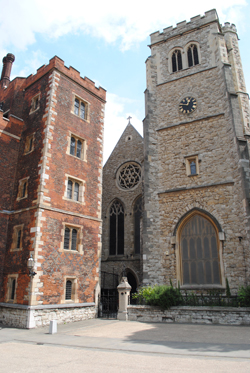The remains of several archbishops of Canterbury are believed to have been found beneath a former parish church in Lambeth. Workers were carrying out renovation works at the deconsecrated St Mary-at-Lambeth, removing flagstone, when they found a hitherto unknown crypt containing some 20 lead coffins one of  which had a small gold archbishops’ mitre resting on top of it. Among those whose coffins have been identified are those of Archbishop Richard Bancroft (in office 1604-1610), who played an important role in the creation of the King James Bible, and Archbishop John Moore (1783-1805) as well as Moore’s wife Catherine and that of John Bettesworth, Dean of Arches, Judge of the Archbishop Prerogative court. It is also believed that archbishops Frederick Cornwallis (1768-1783), Matthew Hutton (1757-1758) and Thomas Tenison (1694-1715) were buried in the tomb under the church’s chancel. The church, which is located beside the River Thames adjacent to Lambeth Palace – London home of the archbishops of Canterbury, originally dates from the 11th century and was deconsecrated in the 1960s. The burial place of John Tradescant (c1570-1638), described as the first “great gardener” in British history, it was subsequently transformed into what is now known as the Garden Museum, the world’s first museum of garden history. The museum closed in 2015 for a £7.5 million redevelopment project and is expected to reopen in late May. PICTURE: Top – the lead coffins with metallic bishop’s mitre; a still taken from video posted on the Garden Museum website/Right – St Mary-at-Lambeth (right side of image).
which had a small gold archbishops’ mitre resting on top of it. Among those whose coffins have been identified are those of Archbishop Richard Bancroft (in office 1604-1610), who played an important role in the creation of the King James Bible, and Archbishop John Moore (1783-1805) as well as Moore’s wife Catherine and that of John Bettesworth, Dean of Arches, Judge of the Archbishop Prerogative court. It is also believed that archbishops Frederick Cornwallis (1768-1783), Matthew Hutton (1757-1758) and Thomas Tenison (1694-1715) were buried in the tomb under the church’s chancel. The church, which is located beside the River Thames adjacent to Lambeth Palace – London home of the archbishops of Canterbury, originally dates from the 11th century and was deconsecrated in the 1960s. The burial place of John Tradescant (c1570-1638), described as the first “great gardener” in British history, it was subsequently transformed into what is now known as the Garden Museum, the world’s first museum of garden history. The museum closed in 2015 for a £7.5 million redevelopment project and is expected to reopen in late May. PICTURE: Top – the lead coffins with metallic bishop’s mitre; a still taken from video posted on the Garden Museum website/Right – St Mary-at-Lambeth (right side of image).
John Tradescant
King James I’s London – 8. The New World
It was during the reign of King James I that the first permanent English settlement was made in what was then called the New World (and is now better known as the United States of America).
 Named Jamestown (after the King) and located on Jamestown Island, it was the capital of the new Virginia Colony and was founded by the London Company.
Named Jamestown (after the King) and located on Jamestown Island, it was the capital of the new Virginia Colony and was founded by the London Company.
The ‘discovery’ and settlement of the New World impacted London itself in various ways – here we look at a couple of related sites in London…
First up is Blackwall in East London, from where three small merchant ships of the Virginia Company of London sailed in 1606 under orders from King James I to bring back gold from the New World. The site is now marked by the First Settlers Monument, first unveiled in 1928 and then restored in 1999.
Among those who was on board the ships is Captain John Smith (he of Pocahontas fame) – a statue of him can be found in Bow Churchyard in the City (pictured right, it’s a replica of an original in Richmond, Virginia). Captain Smith was buried in St Sepulchre-without-Newgate, where there is a window commemorating him.
Next we turn to the former, now non-existent, property of John Tradescant and his son, also John Tradescant. Gardeners to the rich and famous and avid collectors of all sorts of artefacts, they are noted for having founded “The Ark” – a house in Lambeth, in they showed off a collection of curiosities that they had gathered on his trips (both were were widely travelled).
These included objects presented to by American colonists including John the Elder’s friend Captain John Smith and those collected by personally by John the Younger (he made several trips to the New World). Among them was the mantle of Powhattan, the father of Pocahontas.
The pair’s name lives on in Tradescant Road in Lambeth (it marks one side of the Tradescant estate). They are both buried at St Mary-at-Lambeth which now houses the Garden Museum.
